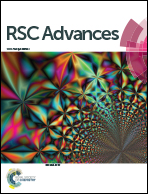Radical-dominated reaction of CO–NO on a CaFe2O4 surface in sintering flue gas recirculation†
Abstract
The catalytic reduction behaviours between NO and CO on a CaFe2O4 surface were studied using flue gas recirculation. The reaction mechanism and control principle were investigated via experiment and theoretical calculations. The experiment results show that CaFe2O4 can catalyse the reduction of NO by CO, and the NO conversion rate increases with the increase in CO concentration. The theoretical calculations indicate that the CO–NO reaction on CaFe2O4 surfaces complies with the Eley–Rideal mechanism, and the reaction path is controlled by nitrogen, oxygen and isocyanate radicals. Specifically, the dissociation of NO into nitrogen and oxygen radicals, and the formation of subsequent isocyanate radicals dominate the reaction. The results provide new insight into the intrinsic reaction mechanism and the meso-scale control principle, allowing us to propose a novel process design scheme to improve the NOx emission reduction efficiency in the flue gas recirculation process.



 Please wait while we load your content...
Please wait while we load your content...